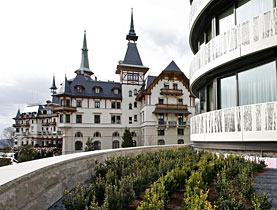
Revamped luxury hotel throws open its doors

The Dolder Grand hotel, a Zurich landmark, is reopening on Thursday after a SFr440 million ($443 million) facelift by British star architect Norman Foster.
swissinfo joined the crowds at the public viewing days for a sneak preview of changes to the luxury establishment.
The Dolder, perched on the Zurichberg hill above Switzerland’s financial centre, has been an integral part of the city for more than a century.
In its heyday, the luxury resort, with its fine views of the Alps and the city, attracted such names as former United States President John F. Kennedy, the shah of Iran and the Rolling Stones.
Its reopening after four years of extensive work was bound to arouse curiosity. But even Dolder officials said they were surprised by the scale of the interest.
Early on the second day of viewing several hundred people – mostly grey-haired pensioners, but also young families – were already patiently waiting for the five star hotel’s doors to open.
We later learned that Thursday evening’s viewing alone had attracted 4,000 people.
The hotel has undergone a radical transformation. The original fairytale-castle building from 1899 still stands but everything added since then has been ripped down and replaced by two modern glass and aluminium extensions.
According to Foster, these gently curving wings have been designed in harmony with the old building and the hillside forest surroundings.
Old and new
This fusion of old and new is apparent inside the hotel as well. In the castle part the impressive chandelier-clad lobby and the wooden staircase have been restored using original photos. However, the bar combines historic painted ceilings with modern metallic lights.
The rooms shown to the public were furnished in cool browns and lilacs – and had luxury bathrooms and great views.
But the wings, which have doubled the hotel’s area, are more resolutely modern. One houses a 4,000-square-metre spa area which includes a gym, 21 treatment rooms and a tear-shaped swimming pool overlooking the Alps.
The hotel now has a total of 173 rooms and suites. Four top luxury suites – which we didn’t see – cater for “individual extravagance”, with the largest one, the Maestro, stretching over 400 metres across two floors.
Prices range from SFr840 for a double room to up to SFr14,000 for the Maestro.
Crowd pleased
Despite the fact that many walls and floors were covered with protective plastic, there was still much to admire – although most of the people who spoke to swissinfo said the hotel was a bit out of their price range.
However, coming back for an afternoon coffee in one of the restaurants open to the public seemed a popular compromise.
“I find the architecture very elegant and clean. Having worked myself in the hotel industry, I like it very much,” Zurich resident Margrit Ramsauer told swissinfo.
“It brings work and value to Zurich,” enthused Manfred Denner from Aargau, along for the tour with his wife.
But some had reservations. “It’s a question of taste. The old and new go together very well but the décor is a bit darker than I’m used to,” said Ramsauer’s friend Christine Michel.
Thomas Schmid, the hotel’s managing director, concedes that reaction may be mixed.
“This new luxury is very individual and is a bit edgy so this means it’s not for everybody,” he told swissinfo after the viewing. “I think the meaning of luxury is more difficult to pin down, for many people it can really mean something different.”
For example, one of the suites, named after the Rolling Stones, has black and pink décor in a 1960s-70s style, which may not please all, admitted Schmid.
No Swiss clichés
But he said the hotel did not want to be a “Disneyland” nor a “potpourri of just Swiss Birchermuesli” clichés.
For this reason Foster’s participation has been key. “Everybody’s competing with this new cult of star architecture and for Zurich it was very important to also have a name on the map,” said Schmid.
All these changes have come at a cost to its owner, Swiss financier Urs Schwarzenbach, with the resort going massively over budget. The hotel says this came from the excavation of the old part, changes to the project and the high cost of materials.
Schmid adds that SFr440 million, although impressive in Switzerland, is not huge on an international scale, and was an investment in a building. Profits will have to be brought back to the owner like any other hotel.
“We were not on the map for four years and in the last years before closing the Dolder had lost a little bit of its glamour and that’s why we had to put so much money into it,” Schmid explained.
“We started from scratch with marketing and publicity. And we don’t have regular guests who will come back, so from this point of view it’s a huge challenge, not only the construction but also to build a successfully running hotel.”
swissinfo, Isobel Leybold-Johnson on the Zurichberg
The hotel opened in May 1899. At the time the health spa was state-of-the art with two lifts and a telephone and telegraph service.
A golf course was added in 1907, a heating system in 1915 and the first major renovations took place in 1924. The entrance was moved to the rear of the hotel. A 60-room wing was added in the 1960s.
Urs Schwarzenbach purchased the property in 2001 and in 2004 it closed for renovation. The hotel reopens on April 3, 2008.
As in 1899, guests will once again enter the south side through the restored stone hall lobby.
In the space of six weeks, more than 110,000 cubic metres of material was excavated from around the historic main building in 2004. The listed monument had to be propped up by a steel corset.
Despite doubling the usable hotel area to 40,000 square metres, geothermics have cut the hotel’s energy consumption by half.
Apart from Foster, interior architects United Designers, from London, shaped the inside and the American Sylvia Sepielli designed the spa.

In compliance with the JTI standards
More: SWI swissinfo.ch certified by the Journalism Trust Initiative
































You can find an overview of ongoing debates with our journalists here . Please join us!
If you want to start a conversation about a topic raised in this article or want to report factual errors, email us at english@swissinfo.ch.